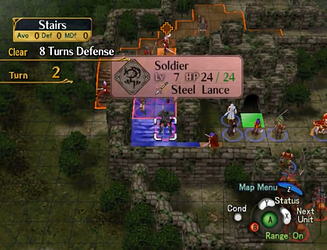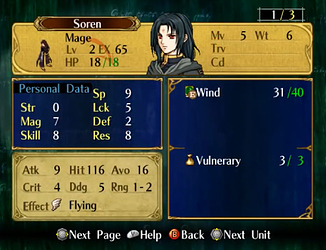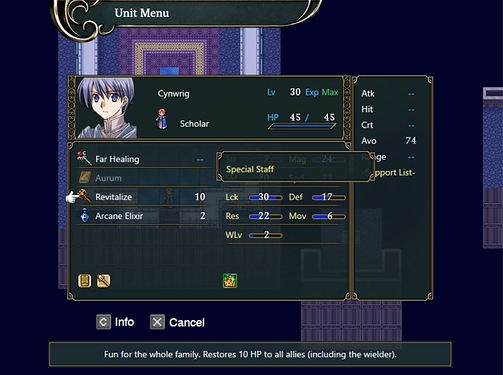Game mods almost invariably make the game harder, including total conversions and not just difficulty/gameplay patches. This makes sense in that if you love a game so much you’re going to make your own fan game or seek one out to play, you want it to present a challenge even to die-hard fans such as yourself who know the game mechanics inside and out. But I think simplification for player accessibility is an underrated topic that doesn’t get a lot of discussion. It is usually redundant: who ever played something like The Last Promise without also having played FE7 first? I offhandedly referred to “game development” in a discussion about hobbies with a colleague once (talking about roms in real life is a no-no; it’s not worth it to go into that discussion), and they told me they would be interested in playing whatever game I was thinking about making if I ever got around to making it. This got me thinking: what if I actually presented a Fire Emblem mod project to this person? I know they play some games, but I don’t think they play any sort of strategy games. What sort of esoteric mechanics that we all take for granted would result in them not being able to make it through the game? I’m not about to actually do it, but it’s an interesting exercise in thought. I don’t bother with tutorials in my game unless there’s a meaningful difference from the norm, and even then it’s nothing more than a short explanation in a message box. Even FE7, with its super hand-holding Lyn Mode, fails to explain every little detail that the player will potentially ignore and get their units killed. How can I make my game more accessible, not only easy enough for laypeople to play but quicker to be understood? I have several ideas to go about doing this, but they’re all rather lacking and I’m interested in hearing if anyone here has any suggestions.
Unit death: the elephant in the room. My very first playthrough of any Fire Emblem game was in FE7, during which most of my units were defeated in Lyn Mode and by chapter 19 of Eliwood Mode I only had the lords, Marcus, and Oswin left. How could I have let things get so bad that I had to restart Eliwood Mode from chapter 11? I distinctly remember feeling like I was cutting losses and that my units’ deaths were necessary sacrifices. Making the whole game be permanently in casual mode feels like an inevitability to me; however, I don’t really want to do this. Casual mode has existed for a long time now and is far from controversial, but “if your units die, they’re gone” has always felt like a big part of Fire Emblem to me, and I don’t want to deny my players the taste of that feeling (as a matter of fact, encouraging the player to accept death is a topic I want to discuss in detail at some point later). Additionally, casual mode completely changes the gameplay meta because kamikaze strategies become viable. The most obvious solution to me is constantly giving the player new units so they can continue on even if everyone but their lords and favourites dies. FE1 does have plenty of expendable units who are basically cannon fodder and get zero lines of dialogue, and FE11 gives you a side story chapter with new units and more exp to be earned if you’re running low on units. There’s probably some Japanese person out there whose favourite Fire Emblem character was Bord because Cain, Abel, and the others died and Bord had to step up. Maybe I could find a middle ground between always-on casual mode and permadeath, like a thing where units need to spend the next chapter resting if they’re defeated or lose levels/stats. However, the former would just encourage alternating between two groups of units to use for kamikaze strategies and the latter encourages the “cut your losses” mentality too much and potentially just digs the player deeper into a hole of the game becoming unwinnable.
Equipment: the weapon triangle definitely lifts a lot of weight already. In my projects, I already tend to change it so it only affects hit and not attack power, and I think I would do the same here. The combined difference of 30 hit between advantage and disadvantage is a huge boon to the player, but the extra point of damage only really helps in the earlygame before it becomes an annoyance and a possible factor that the player will not remember to calculate for. As an esthetic change, I would take a page from Heroes and give swords/axes/lances red/green/blue themes. I would also like to do something with weapon weight, maybe getting rid of the constitution stat entirely and making the baseline iron weapons have 0 or 1 weight. When I was a ten-year-old playing FE7 in 2004, I thought having a high constitution stat was a bad thing because it makes units harder to rescue and I hadn’t learned the concept of attack speed. I used to think it was just because I was a dumb kid, but now I understand it was also an issue with the game not explaining it very well. A village saying “heavier weapons are harder to wield” with no further detail is easily mistaken as flavour text, and even the description of constitution in the status screen only says it “affects rescues”.
Stats: I don’t think there necessarily need to be fewer stats to keep track of, but they could be more intuitive and better explained. Luck, for example, affects critical hit avoidance, regular avoidance, hit, and skill stuff if your game has those, and all the vanilla game tells you is “this affects many things”. The way I see it, each stat can be simplified to having a primary function, with the game being forgiving enough that any secondary function that does exist can be ignored or forgotten about unless you’re a skilled player going for super-optimal strats. My proposed primary function of luck is crit avoidance, although luck’s effects are all so subtle I hesitate to call any of its features extremely meaningful. We could also turn luck into a “critical hit stat” in general if we wanted to decouple crit chance from skill, whose primary purpose is already to increase hit rate, or an “avoidance stat” when the primary purpose of speed is already increasing attack speed. Maybe it would be better to roll with the latter and not have stats add to crit/fortitude at all. Getting screwed by a mercenary who has single-digit crit from their skill stat doesn’t feel good, and the player shouldn’t learn to depend on the same thing happening on their own side.
Speaking of critical hits: double damage instead of triple damage strikes me as a good idea; the same goes for weapon-against-class effectiveness (although I’d buff those weapons a little in return). I would still like to have critical hits as part of the game even without stats increasing crit chance, and the player definitely should be watching out for them, but it could be less of a death sentence if the player does get one of their units critted. I want to encourage the player to try to squirrel up a solution in these scenarios rather than just resign themselves to restarting the chapter as soon as they see the bad guys twirl their weapons. Maybe the “crit bonus” class/character flag is more broadly applicable than to just a few special promoted classes and the ability to crit with ordinary weapons could be a feature for an entire archetype of classes. RNG abusers would have a field day with this, sure, but with non-Fire Emblem gamers as the target audience this isn’t a problem.
Do you have any ideas for making Fire Emblem, or just any strategy game with a similar dynamic, more accessible and easy to get the hang of? Thoughts/solutions on my own ideas? I’d like to hear them.



